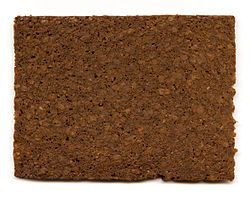Pumpernickel bread

A slice of pumpernickel bread
|
|
| Type | Rye bread |
|---|---|
| Place of origin | Germany |
| Region or state | Westphalia |
| Main ingredients | Rye flour, rye berries |
| |
|
Pumpernickel (English pronunciation: /ˈpʌmpərnɪkəl/; German: [ˈpʊmpɐˌnɪkəl]) is a typically heavy, slightly sweet rye bread traditionally made with sourdough starter and coarsely ground rye. It is often made today with a combination of rye flour and whole rye berries.
At one time it was traditional peasant fare, but largely during the 20th century various forms became popular through delicatessens and supermarkets. Present-day European and North American pumpernickel differ in several characteristics, including the use of additional leaveners, and, in North America, coloring and flavoring agents, the addition of wheat flour, higher baking temperature, and a dramatically shortened baking time.
Pumpernickel has been long associated with the Westphalia region of Germany, first referred to in print in 1450. Although it is not known whether this and other early references refer to precisely the bread that came to be known as Pumpernickel, Westphalian pumpernickel is distinguished by use of coarse rye meal and a very long baking period, which gives the bread its characteristic dark color. Like most traditional all-rye breads, pumpernickel is traditionally made with an acidic sourdough starter, which preserves dough structure by counteracting highly active rye amylases. That method is sometimes augmented or replaced in commercial baking by adding citric acid or lactic acid along with commercial yeast.
...
Wikipedia
